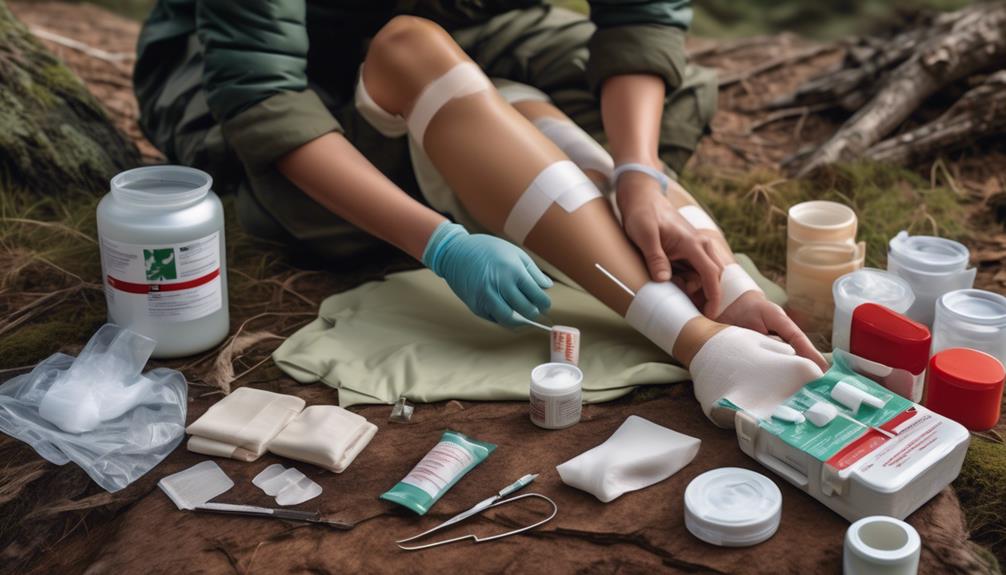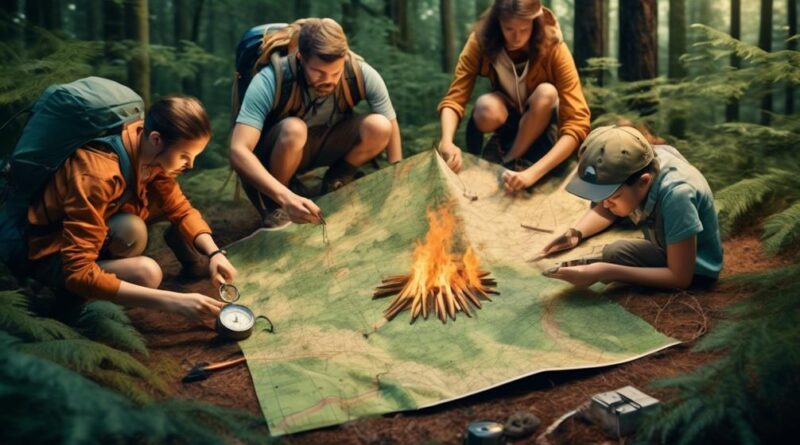14 Tips for Survival Skills Training Adventure Holidays
When you embark on a survival skills training adventure holiday, it's crucial to be well-prepared for the challenges that come with it. Imagine finding yourself in the remote wilderness, equipped with only the essentials and your wits. How would you ensure your safety and well-being?
In this discussion, we'll delve into 14 crucial tips that will not only enhance your survival skills but also make your adventure holiday an unforgettable experience. From choosing the right destination to mastering fire starting techniques, these tips will equip you with the knowledge and confidence to thrive in the great outdoors.
Choosing the Right Destination
When choosing the right destination for your survival skills training adventure holiday, consider the specific terrain and climate that will best challenge and prepare you for real-life survival scenarios. Destination selection is crucial for an authentic experience.
Look for a location that offers a diverse range of terrains such as mountains, forests, and deserts. These varied landscapes will provide you with the opportunity to learn and practice survival skills in different environments.
Additionally, cultural immersion is an essential aspect of your training. Choose a destination where you can interact with local communities and learn from their traditional survival methods. This not only enhances your skills but also fosters a deeper understanding of diverse cultures.
Adventure activities are a key component of survival skills training. Seek destinations that offer activities such as hiking, rock climbing, and wilderness navigation. These activities will challenge you physically and mentally, preparing you for the unexpected in real survival situations.
Furthermore, having local guides is invaluable. They possess in-depth knowledge of the area, including its flora, fauna, and potential hazards. Local guides can also teach you indigenous survival techniques that have been passed down through generations.
Essential Gear and Equipment
To truly prepare for the challenges of diverse terrains and climates, equipping yourself with the essential gear and equipment is paramount for your survival skills training adventure holiday.
When it comes to outdoor clothing, it's crucial to invest in high-quality, weather-appropriate attire. Look for moisture-wicking base layers, insulating mid-layers, and waterproof outer shells to keep you dry and comfortable in varying conditions. Additionally, sturdy hiking boots with good ankle support are a must-have to navigate rough terrain and provide stability.
Camping gear is another essential component of your adventure. A reliable tent that can withstand the elements, a warm sleeping bag, and a durable backpack for carrying your supplies are indispensable. Furthermore, consider bringing a portable water filtration system to ensure a safe drinking water source in remote areas.
Survival tools are vital for handling unexpected situations. A multi-tool with essential functions such as a knife, screwdriver, and bottle opener can be invaluable. Additionally, pack a first aid kit with essential medical supplies and medications tailored to your specific needs. Emergency supplies like a fire starter, compass, and signaling devices are essential for navigating and communicating in the wilderness.
Basic Wilderness First Aid

Equipping yourself with basic wilderness first aid skills is essential for handling medical emergencies in remote and challenging outdoor environments. When you're out in the wilderness, being prepared to handle injuries or sudden illnesses can make a critical difference in the outcome of an emergency situation.
Here are some crucial wilderness first aid tips to keep in mind:
- Assessment and Prioritization: In a wilderness setting, it's vital to quickly assess the situation and prioritize the most critical injuries or illnesses. Learn how to conduct a rapid but thorough assessment of the injured person and determine the appropriate course of action.
- First Aid Techniques: Familiarize yourself with basic first aid techniques that are specifically tailored to wilderness environments. This includes treating common outdoor injuries like cuts, sprains, burns, and insect bites. Additionally, understanding how to manage environmental emergencies such as hypothermia and heatstroke is crucial.
- Emergency Response Planning: Develop a solid understanding of emergency response techniques and protocols. This encompasses knowing how to effectively communicate distress signals, establish evacuation plans, and provide essential care while waiting for professional help to arrive.
Navigation and Map Reading
Developing proficiency in navigation and map reading is crucial for ensuring your safety and successful navigation through remote wilderness areas, complementing your basic wilderness first aid skills. When venturing into the wilderness, having strong compass skills is essential. Make sure you understand how to use a compass to take a bearing and follow it accurately. Knowing how to read a map and relate it to the surrounding terrain is equally important. Understanding contour lines, topographic features, and how to measure distance on a map will greatly aid in your navigation.
Orienteering techniques are also valuable for finding your way in unfamiliar territory. These techniques include using handrails, such as rivers or ridgelines, to guide your way, and aiming off, where you intentionally veer to one side of your target to make it easier to find.
In addition to these skills, it's important to remember that navigation isn't just about finding your way from point A to point B. It's also about being aware of your surroundings and noticing key landmarks that can help you find your way back. Pay attention to the direction of the sun and the time of day to help orient yourself.
Always carry a map and compass as a backup to any electronic navigation devices, as technology can sometimes fail in remote areas. By honing your navigation and map reading skills, you'll be better prepared to handle the challenges of the wilderness and ensure a safe and enjoyable adventure.
Fire Starting Techniques

You can easily ignite a fire using various techniques, such as friction, sparks, or chemical reactions. Mastering these skills is crucial for survival in the wilderness.
Here are some key techniques you should learn:
- Friction Fire: One of the oldest methods for starting a fire is the friction fire technique. It involves using a fire bow drill or a fire plough. With the fire bow drill, a straight stick is rotated in a socket against a flat piece of wood, creating friction and generating heat. The fire plough technique requires a hardwood ploughed along a softer wood to produce enough heat to ignite a fire.
- Flint and Steel Techniques: Another reliable method is using flint and steel to create sparks. This technique involves striking a piece of high-carbon steel against flint, which produces a shower of hot sparks that can ignite dry tinder.
- Chemical Reactions: Chemical reactions can also be used to start a fire. For example, potassium permanganate and glycerin can create a chemical reaction that generates enough heat to ignite a fire.
Shelter Building Fundamentals
Shelter building in the wilderness requires practical skills and resourcefulness to ensure protection from the elements. When it comes to survival skills training, knowing how to construct an emergency shelter using natural materials is crucial. In a survival situation, your ability to quickly create a shelter can mean the difference between comfort and exposure to the elements.
To build an emergency shelter, look for a location with natural features that can provide some protection, such as a rock overhang or a dense cluster of trees. If these options aren't available, you can construct a simple debris shelter using branches, leaves, and other natural materials. Start by creating a framework using sturdy branches, then layer smaller branches, leaves, and any available debris to form a protective barrier. The goal is to insulate yourself from wind, rain, and cold.
Remember that the key to a successful shelter is to work with what nature provides. Avoid expending unnecessary energy and resources. Keep in mind that the shelter should be large enough to accommodate you while allowing for some mobility, but not so large that it becomes difficult to heat with your body warmth.
Water Sourcing and Purification

When venturing into the wilderness, ensuring a reliable source of clean water is essential for your survival. In such environments, water can be found from various natural sources, but it's crucial to purify it to make it safe for consumption.
Here are some tips to help you with water sourcing and purification:
- Water Sources: Look for natural sources of water such as streams, rivers, and lakes. However, be cautious as these sources might still contain harmful bacteria and parasites. Rainwater can also be collected using improvised methods like placing a tarp or any waterproof material to catch the rain.
- Purification Methods: Boiling water is one of the most effective ways to kill harmful pathogens. If you don't have a container to boil water, you can use purification tablets or portable water filters. Alternatively, you can create a simple filtration system using natural materials like sand, charcoal, and gravel.
- Natural Sources: In addition to the water bodies, certain plants can provide you with water. For example, vines like wild grapevines or certain cacti contain water that can be extracted by cutting them open. However, it's crucial to have the knowledge to identify safe sources of water in the wild.
Survival Food Foraging
While navigating the wilderness, a key skill to master is survival food foraging, which involves locating and identifying edible plants and other sources of sustenance. When it comes to foraging for edible plants, it's essential to have a good understanding of the flora in the region. Look for familiar plants like dandelions, wild strawberries, and cattails, which are safe to eat. Avoid plants with a milky sap or thorns, as these are often indicators of toxicity. It's crucial to be cautious and use reliable sources to identify plants before consumption.
In addition to foraging for plants, hunting techniques can also be valuable for sourcing food in the wild. Small game such as rabbits, squirrels, and birds can provide a crucial source of protein. Constructing simple traps and snares using local materials can be an effective method for catching small animals. Understanding the behavior and habits of the local wildlife is essential for successful hunting.
While foraging for survival food, it's important to remember that the goal is sustenance, not gourmet meals. Focus on high-energy foods like nuts, seeds, and edible roots. Prioritize safety and caution when foraging and hunting, and always be certain of the edibility of any plant or animal before consuming it.
With the right knowledge and skills, survival food foraging can provide a vital means of sustaining yourself in the wilderness.
Frequently Asked Questions
What Are Some Common Psychological Challenges People Face During Survival Skills Training Adventures?
When facing survival skills training adventures, common fears can include isolation, uncertainty, and physical discomfort. Mental preparation is key to developing a survival mindset and building emotional resilience to overcome these psychological challenges.
How Can Participants Prepare Themselves Mentally and Emotionally for the Challenges of a Survival Skills Training Adventure Holiday?
To prepare mentally, visualize success and focus on positive self-talk. Emotionally, acknowledge fears and stress, then practice relaxation techniques. Stay open-minded and adaptable to new challenges. Remember, mental preparation and emotional readiness are key for a survival skills training adventure holiday.
Are There Any Specific Cultural Sensitivities or Etiquette That Participants Should Be Aware of When Visiting Certain Destinations for Survival Skills Training?
When visiting certain destinations for survival skills training, it's crucial to be mindful of cultural etiquette and international sensitivities. Respect local customs, traditions, and beliefs. Familiarize yourself with cultural norms to ensure a positive and respectful experience.
Can Participants Expect to Encounter Wildlife During Their Survival Skills Training Adventure, and How Should They Handle These Encounters?
When encountering wildlife during survival skills training, always prioritize safety. Follow expert guidance for wilderness encounters and remember key safety precautions. Stay calm, make noise to alert animals, and never approach or provoke them.
What Are Some Ways to Continue Practicing and Honing Survival Skills After Returning From a Training Adventure Holiday?
After returning from your training adventure holiday, continue learning and apply your survival skills in practical ways. Practice fire-starting, shelter-building, and foraging in local parks or camping trips to stay sharp and prepared.
Conclusion
So, whether you're embarking on a survival skills training adventure holiday for the first time or looking to brush up on your wilderness knowledge, these tips will help you prepare for any outdoor challenge.
Remember to:
- Choose the right destination
- Pack essential gear
- Learn basic first aid
- Practice navigation and map reading
- Master fire starting techniques
- Build shelters
- Source and purify water
- Forage for survival food
With these skills in your arsenal, you'll be ready for any outdoor adventure that comes your way.
